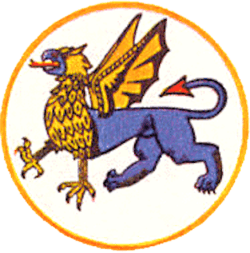50th Fighter-Bomber Squadron
| 50th Fighter-Bomber Squadron | |
|---|---|
|
Emblem of the World War II 50th Bombardment Squadron | |
| Active | 1940-1957 |
| Country | United States |
| Branch | United States Air Force |
| Type | Fighter-Bomber |
The 50th Fighter-Bomber Squadron is an inactive United States Air Force unit. It was last assigned to the 319th Fighter-Bomber Group. It was last stationed at New Orleans NAS, Louisiana, and was inactivated on 16 November 1957.
History
Activated during World War II as an A-20 Havoc light bombardment squadron assigned to Third Air Force. Participated in maneuvers in the southeast prior to World War II. After U.S. entry into the war, the group flew some antisubmarine patrols over the Gulf of Mexico early in 1942. Not deployed to combat duty, it later served as an operational training unit (OTU) until late in 1943, then became a replacement training unit (RTU). Disbanded on 1 May 1944 with the end of the A-20 training program.
Assigned to the reserve in 1947 with second-line B-25 Mitchell medium bombers; upgraded to B-26 Invader light bombers in 1949. Moved from station to station until activated in 1951 due to the Korean War, its personnel and aircraft being sent to Far East Air Forces as replacement aircraft and personnel; inactivated immediately afterward. Redesignated as a Fighter-Bomber squadron and planned for activation with F-84 Thunderstreaks in 1957. Not manned or equipped due to budget shortages and inactivated a few months later.
Lineage
- Constituted 50th Bombardment Squadron (Light) on 20 Nov 1940
- Activated on 15 Jan 1941
- Disbanded on 1 May 1944
- Reconstituted on 10 Mar 1947
- Activated in the reserve on 16 Apr 1947
- Inactivated on 2 Sep 1949
- Activated in the reserve on 10 Oct 1949
- Ordered to active service on 10 Mar 1951
- Inactivated on 22 Mar 1951
- Redesignated 50th Fighter-Bomber Squadron on 12 Feb 1957
- Activated in the reserve 8 Jun 1957
- Inactivated on 16 Nov 1957
Assignments
- 46th Bombardment Group, 15 Jan 1941 – 1 May 1944
- 319th Bombardment Group, 16 Apr 1947 – 2 Sep 1949; 10 Oct 1949-22 Mar 1951
- 319th Fighter-Bomber Group, 8 Jun-16 Nov 1957
Stations
- Hunter Field, Georgia, 15 Jan 1941
- Bowman Field, Kentucky, 19 May 1941
- Barksdale Field, Louisiana, 1 Feb 1942
- Galveston Army Airfield, Texas, 2 Apr 1942
- Blythe Army Air Base, California, 19 May 1942
- Will Rogers Field, Oklahoma, 7 Nov 1942
- Drew Field, Florida, 6 Oct 1943
- Morris Field, North Carolina, 6 Nov 1943 – 1 May 1944
- Mitchel Field, New York, 16 Apr 1947
- Reading Municipal Airport, Pennsylvania, 27 Jun 1949 – 2 Sep 1949
- Birmingham Municipal Airport, Alabama, 10 Oct 1949 – 22 Mar 1951
- New Orleans NAS, Louisiana, 8 Jun-16 Nov 1997
Aircraft
- A-20 Havoc, 1941-1944
- B-25 Mitchell, 1944
- B-26 Invader, 1949-1951
References
![]() This article incorporates public domain material from the Air Force Historical Research Agency website http://www.afhra.af.mil/.
This article incorporates public domain material from the Air Force Historical Research Agency website http://www.afhra.af.mil/.
- Maurer, Maurer, ed. (1982) [1969]. Combat Squadrons of the Air Force, World War II (PDF) (reprint ed.). Washington, DC: Office of Air Force History. ISBN 0-405-12194-6. LCCN 70605402. OCLC 72556.
